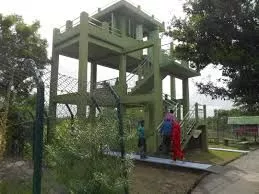SUDHANYAKHALI WATCH TOWER
Sudhanyakhali Watch Tower is situated in the Sundarbans National Park. This watch tower has the power to host 25 people at a single time.
You will get the opportunity to spot a number of tigers from the Sudhanyakhali watch tower including some more wildlife species like axis deers, wild boars and crocodiles which can also be seen from the watch tower.
Besides the watch tower, there is a sweet little pond where animals come to quench their thirst. Behind the pond there are stretches of land which do not have any vegetation where from a distance, you can sight many wild animals.
The Sudhanyakhali Watch Tower offers a special view point to witness the exquisite Bengal tigers. The watchtower which can fit 25 people at a time lets you spot various will species of the Sundarbans forest area such as axis deers, wild boars and crocodiles.
The watch tower has a very strategic location as the freshwater pond which is just next to the tower is the place where all animals come to drink water which makes this position of the watch tower absolutely ideal for wildlife spotting.
Sudhanyakhali Watch Tower is at a distance of 43 kilometers from Canning and can be easily reached via a boat ride through slender creeks and channels of the rivers Pirkhali, Sarakhkhali and Sudhanokhali rivers and the forest Island of Gajikhali. This tower is ideal for spotting tigers and in addition, visitors can also witness a range of other wild animals from the same place.
The place is extremely serene and peaceful which will calm you down from within. Daytime is actually considered to be the best time to visit the Sudhanyakhali watch tower and the best season is believed to be the months between September and March.
You have the option of reaching the Sudhyanyakhali Watch tower from Pakhiral or Dayapur via a boat. After visiting the Sudhanyakhali watch tower, you can move towards Sudhanyakhali view point in your same boat. The Sudhanyakhali view point is a very famous point from where everybody is believed to get a panoramic view of the entire Sundarbans area.
You will get to spot various wild animals like the deer, wild boars, and crocodiles including many others from the watch tower. Also, the garden area is said to have a lot of trees with name plates which will help you in getting familiar with the different varieties of trees that are found in the Sundarbans. You will find several man-made creeks in the area which will help you in getting a clear view of the species that will pass by the area.
You will get to view deer and birds the most in this place. This place also has a lot of monkeys which keep moving and swinging from one place to another. Consider yourself lucky if you get to spot a Tiger in the same area. Witness clear views of internal canals along with a bunch of Deers, Tigers which seem to majorly come here to hunt deers and take some rest. In the past, there used to be a pathway to go to up till some distance inside the forest which now remains closed.
In the same area, you will also find a popular temple of the local goddess Banbibi. The place also has a fascinating museum known as the Mangrove Interpretation Centre where you will get to discover a lot of information about the Sunderbans, wildlife, lifestyle of the local people; activities conducted by forest guards and various types of mangrove trees.
Related Search
- Sundarban Day Tour
- Sundarban 1 Night 2 Days Tour Package
- Sundarban 2 Night 3 Days Tour Package
- Sundarban 3 Nights 4 Days Tour Package
- Sundarban 4 Nights 5 Days Tour Package
- Sundarban wildlife photography Tour Package
- Sundarban Honeymoon Tour Package
- Sundarban Adventure Tour Package
- Sundarban Family Tour Package
- Sundarban Summer Tour Packages
- Sunderban Winter tour Package
- Sundarban Affordable Tour Package
- Sundarban Exotic Tour Package
- Sundarban Luxury Tour Package
- Sundarban Wildlife Tour Packages
